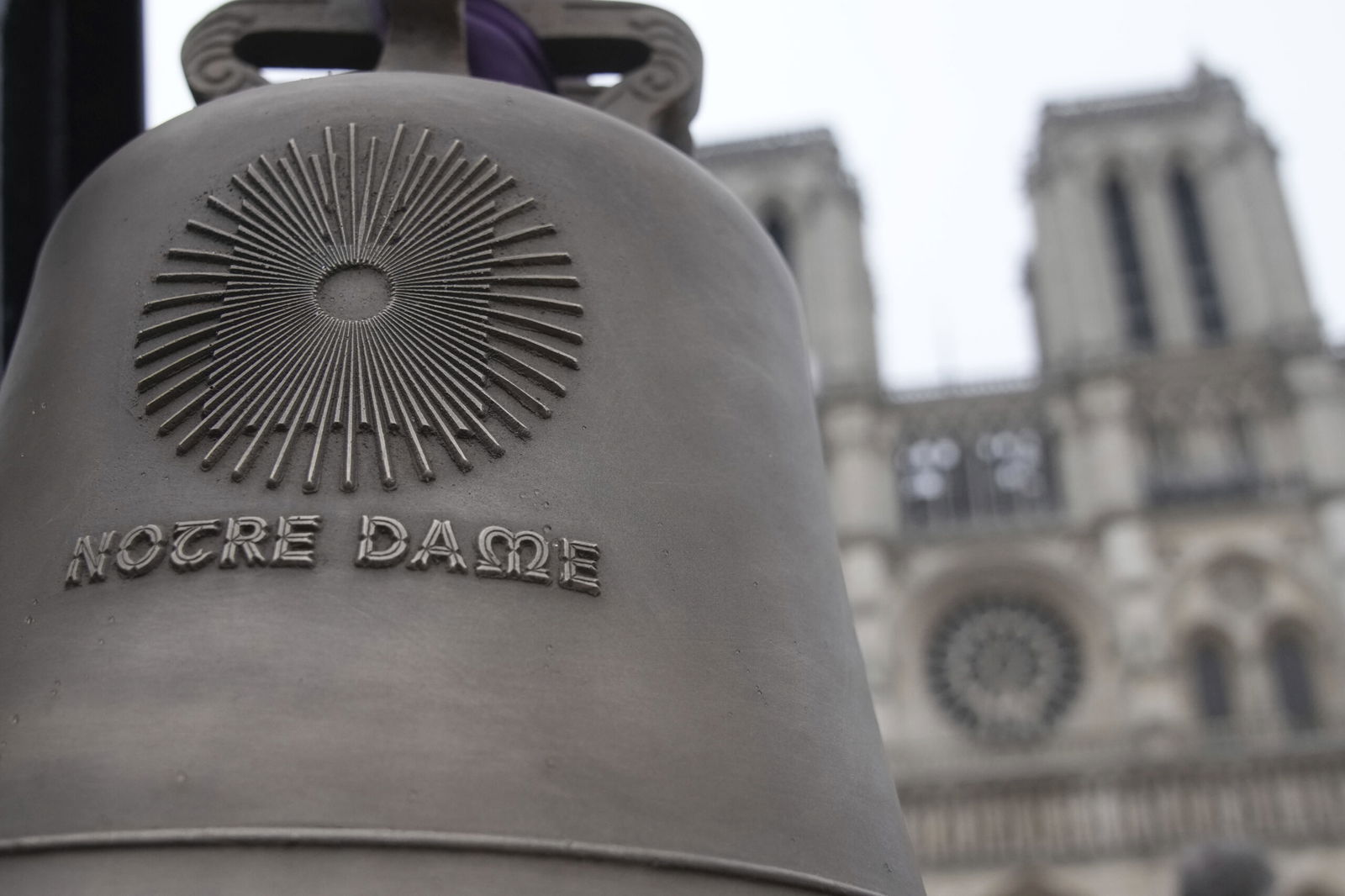Around the World briefs

By Associated Press
Notre Dame marks arrival of Paris Olympics’ iconic trackside bell as cathedral reopening nears
PARIS | Paris’s Notre Dame cathedral, whose historic bells were silenced following 2019’s devastating fire, will soon echo again with fresh chimes.
On Thursday, the Gothic landmark took delivery of three new bells, including one that was used in the city’s Stade de France stadium during this year’s Paris Olympic Games.
The Olympic bell, a gift from the Paris 2024 organizing committee, will be installed alongside two smaller bells, named Chiara and Carlos, above the altar where they will be rung during Mass, officials said.
Their arrival ahead of Notre Dame’s reopening on Dec. 8 marks a milestone in the painstaking restoration and modernization of the 861-year-old cathedral, made famous around the world by Victor Hugo’s “The Hunchback of Notre Dame.”
Olivier Ribadeau Dumas, rector of Notre Dame, expressed gratitude for the bells’ arrival during a ceremony.
“What a joy it is,” he said. “At the most important moment of the Mass these bells will ring, just as they did when the victor of a competition could celebrate their victory.”
During the Paris 2024 Games, the iconic Olympic bell was rung by each track and field winner.
It bears the mark “Paris 2024,” while the two others are adorned with a round symbol combining the image of Notre Dame’s iconic rosary window with a monstrance, a religious vessel central to the cathedral’s altar.
Crafted by the renowned Cornille Havard foundry, in Villedieu-les-Poêles, Normandy, the bells embody France’s distinguished bell-making tradition.
In a solemn moment, Dumas consecrated the bells with holy water and a tree branch.
Standing on the square outside the cathedral, he and Tony Estanguet, head of the Paris 2024 organizing committee, struck the bells with a wooden mallet to mark the occasion.
“What a powerful symbol it is to see this second life given to the Paris 2024 bell, which brought us so many emotions during these Games,” Estanguet said.
The bells replace three that were previously positioned near Notre Dame’s 19th-century spire, which dramatically collapsed during the fire which ripped through the cathedral’s rafters and roof.
The new bells will be placed in a different location within the cathedral, officials said, where their return will add to the soundscape of Notre Dame’s daily life.
They join the eight historic bells from the cathedral’s north tower that were reinstalled in September after being cleaned and renovated.
Those bells—Gabriel, Anne-Geneviève, Denis, Marcel, Étienne, Benoît-Joseph, Maurice, and Jean-Marie—were originally cast in 2013 for Notre Dame’s 850th anniversary.
The cathedral’s two larger bells remain intact on the south tower and were unaffected by the blaze, officials added.
The reconstruction of Notre Dame has involved more than 250 companies and hundreds of skilled craftsmen.
The Olympic bell isn’t the only symbol of old meeting new in Notre-Dame’s evolving restoration.
Perched atop the newly designed spire, a golden rooster, reimagined by chief architect Philippe Villeneuve, marks a blend of the cathedral’s ancient spirit with a modern touch.
The weathervane, which resembles a phoenix with flames licking its wings, is described as a testament to hope and revival.
A tiny grain of nuclear fuel is pulled from ruined Japanese nuclear
plant, in a step toward cleanup
TOKYO | A robot that has spent months inside the ruins of a nuclear reactor at the tsunami-hit Fukushima Daiichi plant delivered a tiny sample of melted nuclear fuel on Thursday, in what plant officials said was a step toward beginning the cleanup of hundreds of tons of melted fuel debris.
The sample, the size of a grain of rice, was placed into a secure container, marking the end of the mission, according to Tokyo Electric Power Company Holdings, which manages the plant. It is being transported to a glove box for size and weight measurements before being sent to outside laboratories for detailed analyses over the coming months.
Plant chief Akira Ono has said it will provide key data to plan a decommissioning strategy, develop necessary technology and robots and learn how the accident had developed.
The first sample alone is not enough and additional small-scale sampling missions will be necessary in order to obtain more data, TEPCO spokesperson Kenichi Takahara told reporters Thursday. “It may take time, but we will steadily tackle decommissioning,” Takahara said.
Despite multiple probes in the years since the 2011 disaster that wrecked the. plant and forced thousands of nearby residents to leave their homes, much about the site’s highly radioactive interior remains a mystery.
The sample, the first to be retrieved from inside a reactor, was significantly less radioactive than expected. Officials had been concerned that it might be too radioactive to be safely tested even with heavy protective gear, and set an upper limit for removal out of the reactor. The sample came in well under the limit.
That’s led some to question whether the robot extracted the nuclear fuel it was looking for from an area in which previous probes have detected much higher levels of radioactive contamination, but TEPCO officials insist they believe the sample is melted fuel.
The extendable robot, nicknamed Telesco, first began its mission August with a plan for a two-week round trip, after previous missions had been delayed since 2021. But progress was suspended twice due to mishaps — the first involving an assembly error that took nearly three weeks to fix, and the second a camera failure.
On Oct. 30, it clipped a sample weighting less than 3 grams (.01 ounces) from the surface of a mound of melted fuel debris sitting on the bottom of the primary containment vessel of the Unit 2 reactor, TEPCO said.
Three days later, the robot returned to an enclosed container, as workers in full hazmat gear slowly pulled it out.
On Thursday, the gravel, whose radioactivity earlier this week recorded far below the upper limit set for its environmental and health safety, was placed into a safe container for removal out of the compartment.
The sample return marks the first time the melted fuel is retrieved out of the containment vessel.
Fukushima Daiichi lost its key cooling systems during a 2011 earthquake and tsunami, causing meltdowns in its three reactors. An estimated 880 tons of fatally radioactive melted fuel remains in them.
The government and TEPCO have set a 30-to-40-year target to finish the cleanup by 2051, which experts say is overly optimistic and should be updated. Some say it would take for a century or longer.
Chief Cabinet Secretary Yoshimasa Hayashi said there have been some delays but “there will be no impact on the entire decommissioning process.”
No specific plans for the full removal of the fuel debris or its final disposal have been decided.
Australia plans a social media
ban for children under 16
MELBOURNE, Australia | The Australian government announced on Thursday what it described as world-leading legislation that would institute an age limit of 16 years for children to start using social media, and hold platforms responsible for ensuring compliance.
“Social media is doing harm to our kids and I’m calling time on it,” Prime Minister Anthony Albanese said.
The legislation will be introduced in Parliament during its final two weeks in session this year, which begin on Nov. 18. The age limit would take effect 12 months after the law is passed, Albanese told reporters.
The platforms including X, TikTok, Instagram and Facebook would need to use that year to work out how to exclude Australian children younger than 16.
“I’ve spoken to thousands of parents, grandparents, aunties and uncles. They, like me, are worried sick about the safety of our kids online,” Albanese said.
The proposal comes as governments around the world are wrestling with how to supervise young people’s use of technologies like smartphones and social media.
Social media platforms would be penalized for breaching the age limit, but under-age children and their parents would not.
“The onus will be on social media platforms to demonstrate they are taking reasonable steps to prevent access. The onus won’t be on parents or young people,” Albanese said.
Antigone Davis, head of safety at Meta, which owns Facebook and Instagram, said the company would respect any age limitations the government wants to introduce.
“However, what’s missing is a deeper discussion on how we implement protections, otherwise we risk making ourselves feel better, like we have taken action, but teens and parents will not find themselves in a better place,” Davis said in a statement.
She added that stronger tools in app stores and operating systems for parents to control what apps their children can use would be a “simple and effective solution.”
X did not immediately respond to a request for comment on Thursday. TikTok declined to comment.
The Digital Industry Group Inc., an advocate for the digital industry in Australia, described the age limit as a “20th Century response to 21st Century challenges.”
“Rather than blocking access through bans, we need to take a balanced approach to create age-appropriate spaces, build digital literacy and protect young people from online harm,” DIGI managing director Sunita Bose said in a statement.
More than 140 Australian and international academics with expertise in fields related to technology and child welfare signed an open letter to Albanese last month opposing a social media age limit as “too blunt an instrument to address risks effectively.”
Jackie Hallan, a director at the youth mental health service ReachOut, opposed the ban. She said 73% of young people across Australia accessing mental health support did so through social media.
“We’re uncomfortable with the ban. We think young people are likely to circumvent a ban and our concern is that it really drives the behavior underground and then if things go wrong, young people are less likely to get support from parents and carers because they’re worried about getting in trouble,” Hallan said.
Child psychologist Philip Tam said a minimum age of 12 or 13 would have been more enforceable.
“My real fear honestly is that the problem of social media will simply be driven underground,” Tam said.
Australian National University lawyer Associate Prof. Faith Gordon feared separating children from there platforms could create pressures within families.
Albanese said there would be exclusions and exemptions in circumstances such as a need to continue access to educational services.
But parental consent would not entitle a child under 16 to access social media.
Earlier this year, the government began a trial of age-restriciton technologies. Australia’s eSafety Commissioner, the online watchdog that will police compliance, will use the results of that trial to provide platforms with guidance on what reasonable steps they can take.
Communications Minister Michelle Rowland said the year-long lead-in would ensure the age limit could be implemented in a “very practical way.”
“There does need to be enhanced penalties to ensure compliance,” Rowland said.
“Every company that operates in Australia, whether domiciled here or otherwise, is expected and must comply with Australian law or face the consequences,” she added.
The main opposition party has given in-principle support for an age limit at 16.
Opposition lawmaker Paul Fletcher said the platforms already had the technology to enforce such an age ban.
“It’s not really a technical viability question, it’s a question of their readiness to do it and will they incur the cost to do it,” Fletcher told Australian Broadcasting Corp.
“The platforms say: ‘It’s all too hard, we can’t do it, Australia will become a backwater, it won’t possibly work.’ But if you have well-drafted legislation and you stick to your guns, you can get the outcomes,” Fletcher added.
Deforestation in Brazil’s Amazon drops by nearly 31% compared to previous year
AGUA CLARA, Brazil | Forest loss in Brazil’s Amazon dropped by 30.6% compared to the previous year, officials said Wednesday, the lowest level of destruction in nine years.
In a 12-month span, the Amazon rainforest lost 2,428 square miles, roughly the size of the U.S. state of Delaware.
The results, announced in Brazil´s presidential palace, sharply contrast with President Luiz Inácio Lula da Silva’s predecessor, far-right leader Jair Bolsonaro, who prioritized agribusiness expansion over forest protection and weakened environmental agencies. Deforestation hit a 15-year high during his term.
Deforestation in Brazil’s vast savannah, known as the Cerrado, decreased by 25.7%, the first decline in five years. The area destroyed reached 3,156 square miles. Located in central Brazil, it is the world’s most biodiverse savannah but has fewer legal protections than the Amazon.
Despite the success in curbing Amazon deforestation, Lula’s government has been criticized by environmentalists for backing projects that could harm the region, such as the pavement of a highway that cuts from an old-growth area, oil drilling in the mouth of the Amazon River and building a railway to transport soy to Amazonian ports.
Brazil’s deforestation monitoring system tracks Aug. 1 to July 30, so Wednesday’s report doesn’t capture the destruction from the past few months, as a historic drought opened the way to a surge in forest fires that burned an area larger than Switzerland.
Much of the damage from fires is classified as degradation, not clearcutting deforestation, as the fire in the Amazon rainforest spreads mostly through leaves on the ground, and not through treetops. But the full impact will be assessed in the following months through further satellite monitoring. Government officials already fear that the deforestation rate may increase next year as the Amazonian city of Belem prepares to host the annual U.N. climate talks, known as COP30.
The Amazon, an area twice the size of India, holds the world’s largest rainforest, about two-thirds of it within Brazil. It stores vast amounts of carbon dioxide, a greenhouse gas that causes climate change. The Amazon thus prevents the climate from warming even faster than it would otherwise. The basin also holds about 20% of the world’s fresh water and biodiversity includes 16,000 known tree species.
—From AP reports


